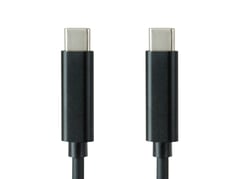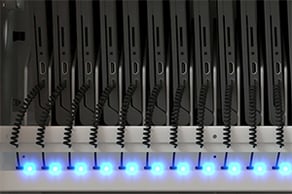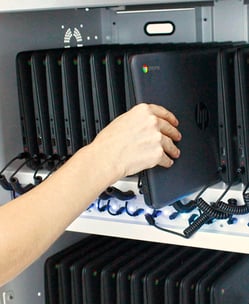USB-C Power Delivery Transformative Benefits to Classroom Device Management in EdTech
 In recent years lesson plans have leaned more heavily on the use and implementation of technology within the classroom. This, in turn, has created a demand for technological advancements in order to provide seamless transitions within the classroom. Efficient charging of student devices is a vital aspect of successful learning outcomes. USB-C PD technology is helping many school districts achieve their goals to keep active devices in students' hands.
In recent years lesson plans have leaned more heavily on the use and implementation of technology within the classroom. This, in turn, has created a demand for technological advancements in order to provide seamless transitions within the classroom. Efficient charging of student devices is a vital aspect of successful learning outcomes. USB-C PD technology is helping many school districts achieve their goals to keep active devices in students' hands.
When referring to USB, USB-A most likely comes to mind. USB-A is commonly found in flash drives, wall chargers, and laptops with rectangular ports. For a comprehensive history of USB ports and charging, check out our previous article. While USB-A is very well known, there is a newer development in USB technology that we will dive into deeper throughout this article.
In recent years, new technology has emerged allowing for a faster and more universal charging experience which is commonly known as USB-C. While these technological advancements are beneficial, understanding how USB PD operates is vital in efficiently transforming classroom device management. We have put together some informative facts and helpful tips to help you fully understand your USB-C charging experience in the classroom!
Key Takeaways:
- USB-C PD can charge devices up to 70% faster than the standard 12W USB-A, increasing instructional time in the classroom by keeping devices active in students’ hands
- USB-C PD enables two-way power, impressive data transfer of 10 Gbps, and charging power up to 240W—enough power to charge a laptop
- USB-C PD allows for universal charging of all device types without needing to wire carts or stations for device charging, saving technology teams time and resources
- New USB-C charging hubs charge devices more efficiently, making it easier for school districts to support multiple device types
-
USB Power Delivery bridges the charging gap and alleviates charging challenges in school districts
USB-C Power Delivery Offers More Value in the Classroom

USB PD can charge devices up to 70% faster than the standard 12W USB-A. When comparing USB PD to the standard USB-C, USB PD charges devices 6x faster than standard USB-C. This makes USB PD technology the fastest charging method currently available! USB-C is an industry-standard connector for transmitting both data and power on a single cable. USB Power Delivery is the technology that makes charging quicker using a USB Type C cable. USB-C cables can carry substantially more power, so they can be used to charge larger devices such as laptops or Chromebooks. USB Power Delivery (PD) allows for faster and more flexible charging that supports up to 240W of power.
Universal Device Support
Gone are the days of having a unique AC adapter for each type of device. This makes it much easier for school districts to support multiple device types and to refresh their devices without constant expenses and dedication of resources to change AC adapters or entire carts/stations that are not compatible with their new devices.
In basic terms, USB PD enables devices to communicate with one another to deliver a quick and balanced charge. When two USB PD devices are plugged in and connected, they begin to negotiate and communicate with one another. This negotiation involves the amount of power that the source device can output and the amount that the recipient device can safely handle. In other words, USB-C is bi-directional. This means that devices can either send or receive the power needed to charge a specific device as quickly as possible without delivering too much, resulting in ideal and balanced charging each time. In turn, this eliminates the potential issue of overheating or damaging devices while charging.
New Hubs Charge Devices More Efficiently
Along with being useful in AC adapters, USB-C PD technology can also be harnessed in multi-port hubs such as JAR Systems' Quick-Sense USB-C Hubs. If there are multiple peripherals connected to a USB PD power source, then each device only gets the amount of power it needs. When a device needs more power to charge, it receives that amount for the duration of the specific need and then decreases down to a lower level of power use. This is especially useful in classrooms where multiple devices need to be charged simultaneously to ensure maximum instructional time. For this reason, the required voltage and wattage should be heavily considered in order to ensure that the needed power will be achieved and delivered to each student's device. With the proper charging aspects required for your devices listed above, USB PD can significantly transform the technological landscape of school classrooms and increase digital equity.
It is also important to consider the voltage levels that a device needs in order to maintain a full charge. While USB PD never exceeds 5A of current, the voltage can be adjusted to meet the needs of a device up to the maximum power limit. USB PD supports 7 voltage levels at 5V, 9V, 15V, 20V, 28V, 36V, and 48V.

Best of all, USB PD allows for universal charging of all device types without needing to wire carts or stations for device charging! Emulator cables are available for older devices that do not have USB-C ports. This allows for a universal charging experience while reducing cable clutter, which makes Technology Directors' jobs more seamless and manageable!
While this aspect is often forgotten, the cable that connects your device and the USB PD charger is a crucial component. Power can only be used at a rate that the cable being utilized can handle. Simply put, you can only reach a level of power such as 100W or 240W if the cable you are using supports it. This is frequently stated in the cable’s specifications, but as previously stated, the charger and device will negotiate and communicate the fastest power rate that the other components can handle whether it’s the charger, cable, or device. This makes it crucial to choose a high-quality cable in order to enjoy fast and balanced USB PD charging in schools where devices such as Chromebooks need to maintain a charge for daily lessons.
USB Power Delivery Bridges the Charging Gap
The future of charging is USB-C PD and it does not seem to be going away anytime soon. USB-C Power Delivery eliminates the need to wire charging stations or carts, saving resources and increasing instructional time in the classroom. USB-C PD bridges the technological gap between school districts’ challenges with charging in the classroom and the efficient technological landscape that they wish to achieve. Products that utilize USB-C PD technology allow for universal, balanced, low maintenance, and quick charging which has limitless benefits for technology teams and the end user.

The Elevate Cart features 32 USB-C charging ports for devices. It is designed to interchangeably charge Chromebooks, tablets, phones, and other mobile devices that utilize the new industry standard USB-C charging port. You can even leverage USB-C PD for all devices with emulator cables to connect older devices to USB-C PD charging, available for the most common charging ports. Elevate USB-C Charging Carts eliminate the extra work of wiring carts through the new Quick-Sense charging hubs and create a better experience for teachers and students. Powered by Quick-Sense USB-C PD charging, Elevate carts intelligently distribute power to your devices without using AC adapters. Best of all, the Elevate cart alleviates challenges in the classroom, saves resources, bridges the charging gap, and transforms classroom device management ensuring maximum student success.

